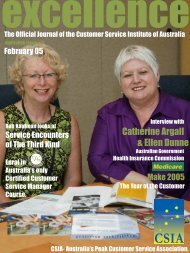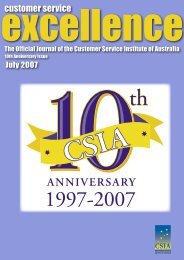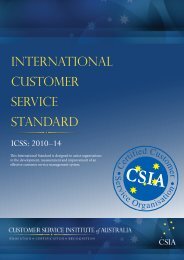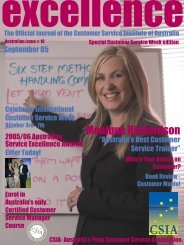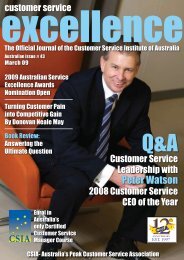Q&A with St.George Bank Limited - Customer Service Institute of ...
Q&A with St.George Bank Limited - Customer Service Institute of ...
Q&A with St.George Bank Limited - Customer Service Institute of ...
You also want an ePaper? Increase the reach of your titles
YUMPU automatically turns print PDFs into web optimized ePapers that Google loves.
A Key Tool in CSIA’s Methodology -<br />
Activity Based Costing (ABC)<br />
Activity based costing is an accounting<br />
methodology that assigns costs to activities<br />
rather than products or services. This enables<br />
resource and overhead costs to be more<br />
accurately assigned to the products and the<br />
services that consume them.<br />
With activity based costing, organisations<br />
can identify where to remove waste, improve<br />
processes and eliminate re-work, as well as<br />
understanding what drives their costs. They<br />
can also see the degree <strong>of</strong> alignment <strong>of</strong> their<br />
cost structure <strong>with</strong> their organisation’s mission<br />
and strategy. CSIA believes that utilising ABC<br />
to establish Activity-Based output data serves<br />
as enabler for ongoing improvement programs.<br />
Key steps in the methodology involve defining<br />
the major business processes and key activities<br />
<strong>of</strong> the organisation using Process and <strong>Customer</strong><br />
Touchpoint Mapping and tracing operating costs<br />
and capital charges to key activities.<br />
The tables below demonstrate the differences<br />
between traditional accounting models (general<br />
ledger style) and activity based cost accounting<br />
models, for an Insurance Company’s claims<br />
department.<br />
Both styles <strong>of</strong> accounting are required, yet that<br />
<strong>of</strong> most immediate value in allowing managers<br />
to make decisions is the one on the right – the<br />
activity-based view. The general difference<br />
between the two is the structure:<br />
Traditional Accounting (General Ledger) View<br />
Claims Processing Department<br />
Actual ($) Plan ($)<br />
Favourable /<br />
Unfavourable<br />
Salaries 621,400 600,00 (21,400)<br />
Equipment 161,200 150,000 (11,200)<br />
Travel Expenses 58,000 60,000 2,000<br />
Supplies 43,900 40,000 (3,900)<br />
Use and occupancy 30,000 30,000 ---<br />
TOTAL $914,500 ($34,500)<br />
Activity-Based View<br />
Claims Processing Department<br />
Key / scan claims $31,500<br />
Analyse and re-work claims $121,000<br />
Suspend claims $32,500<br />
Receive provider enquiries $101,500<br />
Resolve member problems $83,400<br />
Attend training $45,000<br />
Determine eligibility $119,000<br />
Make copies $145,500<br />
Write correspondence $77,100<br />
Process batches $158,000<br />
TOTAL $914,500<br />
As we can see from the above tables, the<br />
activity-based view allows more transparency<br />
<strong>of</strong> where activities that stem from ‘bad service’<br />
exist and how much they cost. In this view,<br />
we can see that “Analyse and re-work claims”<br />
along <strong>with</strong> “Resolve member problems” are<br />
high volume areas. In making one or two<br />
efficiency changes, the organisation has<br />
an opportunity to save money and improve<br />
service to customers.<br />
CUSTOMER SERVICE EXECELLENCE<br />
THE MONTHLY MAGAZINE OF THE CUSTOMER SERVICE INSTITUTE OF AUSTRALIA<br />
10




